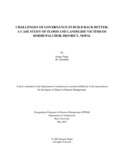| dc.contributor.advisor | Chowdhooree, Imon | |
| dc.contributor.author | Thapa, Saugat | |
| dc.date.accessioned | 2024-01-11T05:00:10Z | |
| dc.date.available | 2024-01-11T05:00:10Z | |
| dc.date.copyright | 2023 | |
| dc.date.issued | 2023-05 | |
| dc.identifier.other | ID 20268006 | |
| dc.identifier.uri | http://hdl.handle.net/10361/22118 | |
| dc.description | This thesis is submitted in partial fulfillment of the requirements for the degree of Bachelor of Architecture, 2023. | en_US |
| dc.description | Cataloged from PDF version of thesis. | |
| dc.description | Includes bibliographical references (pages 51-55). | |
| dc.description.abstract | Build Back Better is challenging in the reconstruction and resettlement of private housing for landslide and flood victims in Sindhupalchok district. The process starts with the Kobo survey, followed by beneficiary verification and approval from MIS in three level-Municipal level, District Level, and National Level, allocation of budget, agreement for releasing grants, and management of safe land for resettlement.
The main actors in this process are the Municipality, District Administration Office, and National government body in reference to Local Disaster Management Committee (LDMC) and District Disaster Management Committee (DDMC) decision. A total of 10 DAO staff, 12 Disaster focal Persons, and 18 FGD respondents were involved in this study. It was found that the Municipality roles start with the Kobo survey after the disaster, verification, and approval of beneficiaries in MIS and forward it to DAO. Besides this Municipality have a role in the management of funding a certain percentage to its beneficiaries and helps for reconstructing their houses in the overall process. DAO has a major role in the verification and approval of beneficiaries forwarded by the municipality in MIS and releases the installments and monitors the reconstruction and resettlement process. The national government plays an active role in the implementation of guidelines and coordination of different agents in the process.
The study finds that each actor faces challenges in their roles some are common and some different. The Municipality faces a lack of technical human resources, whereas DAO faces difficulties in functioning MIS and coordination with different stakeholders. The challenges of lack of human resources can be taken as common and the functioning of MIS was also a challenge for all. Different challenges according to their role have been found in this study. The landslide and flood victims face challenges with document retrieval, lack of awareness about the process, and long procedures. The findings suggest that every gap in the process needs to be addressed to make the reconstruction and resettlement process effective. | en_US |
| dc.description.statementofresponsibility | Saugat Thapa | |
| dc.format.extent | 55 pages | |
| dc.language.iso | en | en_US |
| dc.publisher | Brac University | en_US |
| dc.rights | Brac University theses are protected by copyright. They may be viewed from this source for any purpose, but reproduction or distribution in any format is prohibited without written permission. | |
| dc.subject | Build Back Better | en_US |
| dc.subject | Private housing | en_US |
| dc.subject | Flood victims | en_US |
| dc.subject | Local disaster management | en_US |
| dc.subject.lcsh | Disaster relief | |
| dc.subject.lcsh | Regional planning | |
| dc.subject.lcsh | Natural disasters | |
| dc.title | Challenges of governance in build back better: a case study of flood and landslide victims of Sindhupalchok District, Nepal | en_US |
| dc.type | Thesis | en_US |
| dc.contributor.department | Department of Architecture, Brac University | |
| dc.description.degree | B. Architecture | |

